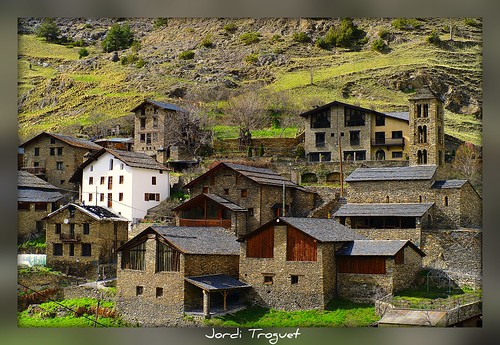
This country, located in the heart of the Pyrenees, leads the traveler to try to understand the relationship between man and nature, and try to interpret the signs specific to the environment, colors, noise, water …. In the end to unclog senses in order to deepen the true identity of the mountain, so unknown and so attractive at a time.
The Principality of Andorra is located in the eastern Pyrenees between Spain and France: with an area of 468 km. square, a town of about 90,000 and its average altitude is about 2,000 meters. Andorra also has a parliamentary principality and adopted its Constitution on 14 March 1993. The head of state rests with the figure of Episcopal Co-Prince, the Bishop of Seu d’Urgell and the French Co-Prince, President of the French Republic.
Its territory consists of a massif belonging to the axial zone «Pyrenean» due to glacial action and river have formed numerous lakes, big circus, long ridges, steep slopes and valleys U-shaped.
The river system is dependent Andorran Segre river, by D’Orient and Valira Valira Nord, who join in forming the river Les Escaldes GrandValira.

The climate is cold with abundant snowfall in winter and rainy in summer, its landscape is dominated by lush forests, numerous lakes, high mountains and large meadows.
The traditional economy based on agriculture and cattle farming has been relegated to the booming trade in imported goods (favored by the low level of taxation, which has encouraged the banking institutions), which attracts French and Spanish . And it has led to a large increase in population, concentrated mainly in Andorra la Vella, Les Escaldes. The main crops are rye and snuff. The industry is almost nonexistent (production of cigarettes), Andorra has a hydroelectric plant at Les Escaldes, whose output is used for local consumption and is partly exported to France and Spain.
As the main engine of its economy is tourism, which gives life to the numerous shops of all kinds, hotels, restaurants and all its resorts. Andorra consists of seven parishes that according to protocol are: Canillo, Encamp, Ordino, La Massana, Andorra la Vella, Sant Julia de Loria and Escaldes Les.
Points of Tourist Interest Romanesque Art in Andorra:
The list is as follows:
– Parroquia de Canillo.
– Canillo: Parish Church of Sant Cerní.
– Prats: Creu dels Braços September. Church of Sant Miquel.
– Meritxell: Sanctuary of Meritxell.
– Caselles: Iglesia de Sant Joan de Caselles.
– El Tarter: Church of Sant Pere del Tarter.
– Parish of Encamp.
– Encamp: Church of Santa Eulàlia.
– Vila d’Estremera: Church of Santa Maria d’Estremera.
– Les Bons: Church of Sant Romà.
– Parish of Ordino.
– Ordino: Church of Sant Corneli i Sant Cebrià d’Ordino.
– Sarcastically: Rock carvings.
– The Cortinada: Church of Sant Martí.
– Llorts: Source and Source Iron Cross.
– Parish of La Massana.
– La Massana: Iscle i Sant Santa Victoria.
– Sispony: Church of Sant Joan. Ruins Sispony mills. Sant Cristòfol.
– Pal: Church of Sant Climent.
Parish, Andorra la Vella.
– Andorra la Vella: Church of Sant Esteve. Barri de Sant Esteve. Casa de la Vall. Pont dels Escalls (Roman bridge).
– Santa Coloma d’Andorra: Parish Church. Castell de Sant Vicenç de Montclar. Pont de la Margineda.
– Parroquia de Sant Julia de Loria.
– SantJuliaLoria: i Sant Julià de Loria Sant Germà. Molina House.
– Aixovall: Chapel of Santa Filomena. Roman bridge.
– Bixessarri: Old houses Andorra, near a small church.
– Sanctuary of Canòlic.
– Cal Bringuer: One of the oldest houses in the valley. Romanesque church of Sant Mateu.
– Fontaneda: Church of Sant Miquel.
– Mas d’Alins: Iglesia de Sant Esteve.
– Aixirivall: Church of Sant Pere.
– Aubinyà: Church of Sant Romà.
– Juberri: Church of Sant Pere.
– Nagol: Sant Martí and Sant Cerni of Nagol.
– Parroquia de les Escaldes-Engordany.
– Les Escaldes: Hot springs. Church of Sant Jaume.
– El Vilar d’Engordany: Church of Sant Miquel d’Engolasters.

See you tomorrow…
Leave a Reply
You must be logged in to post a comment.
Recent Comments